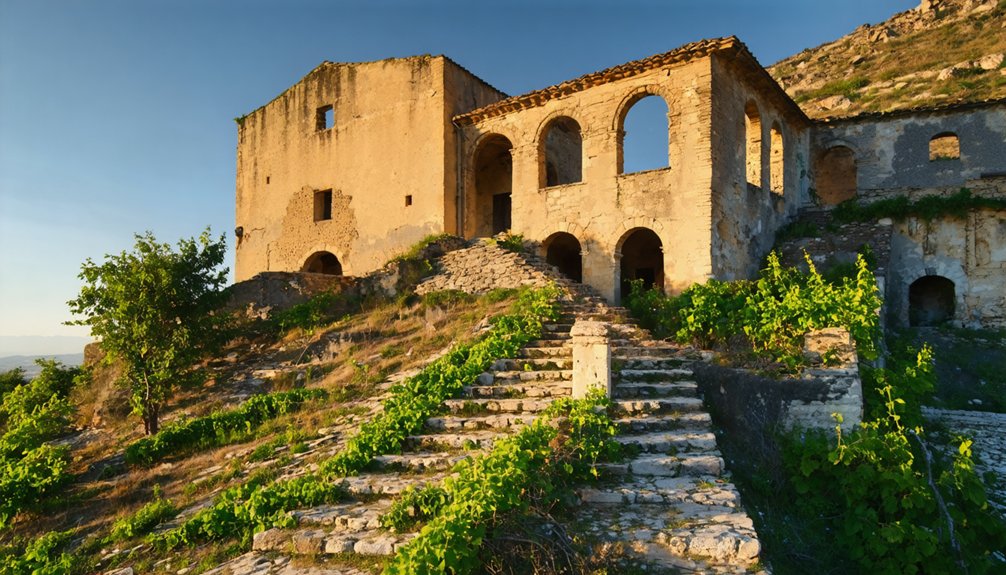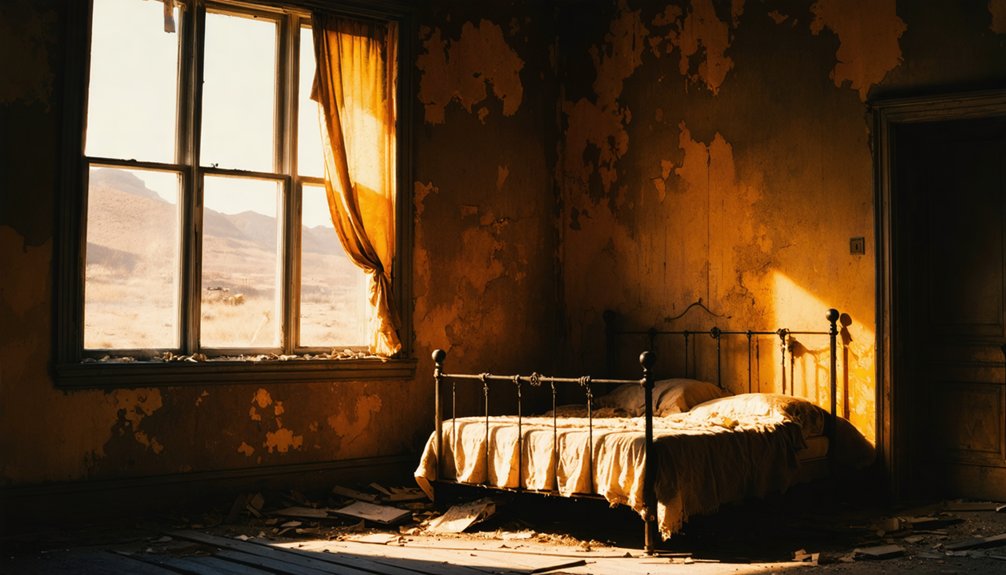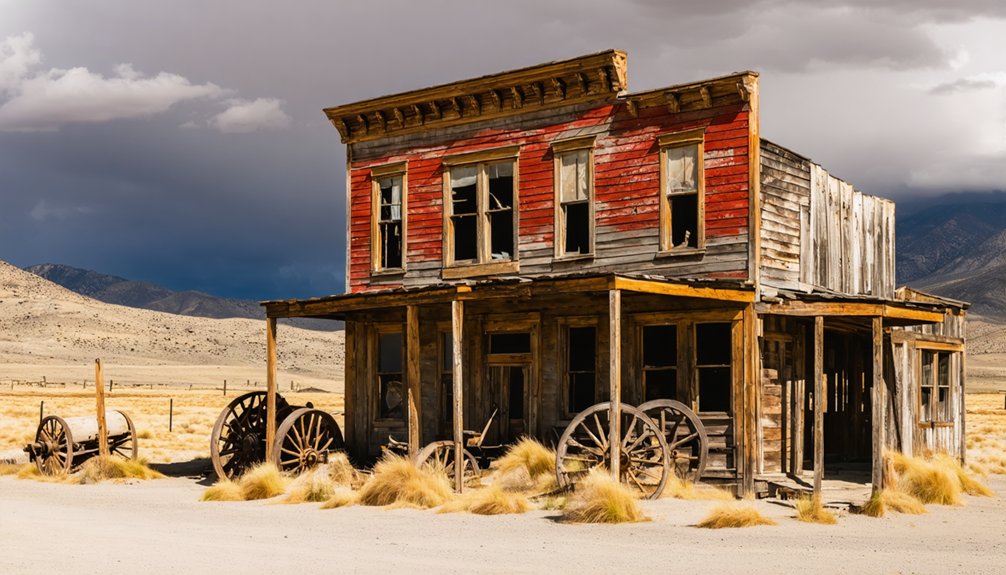Beautiful abandoned towns offer haunting yet enchanting glimpses into forgotten pasts. You’ll find vine-covered buildings in China’s Houtouwan, sand-filled rooms in Namibia’s Kolmanskop, and the frozen-in-time streets of Italy’s Valle dei Mulini. Nature reclaims these once-thriving communities with emerald canopies, indoor dunes, and moss-blanketed stones. From mining boomtowns to tragedy-marked sites, these ghostly settlements reveal stories waiting in their silent, crumbling walls.
Key Takeaways
- Houtouwan, China features abandoned homes dramatically overtaken by lush green vines, creating a fairytale-like appearance.
- Kolmanskop, Namibia showcases hauntingly beautiful sand-filled colonial buildings slowly being reclaimed by the desert.
- Pripyat, Ukraine offers a time capsule of Soviet life with nature reclaiming the abandoned buildings after the Chernobyl disaster.
- Kayaköy, Turkey presents hundreds of stone houses cascading down hillsides, abandoned during the 1923 population exchange.
- Hashima Island, Japan features dramatic concrete ruins rising from the sea, once home to thousands of coal miners.
Ancient Ruins: Time-Frozen Archaeological Wonders
Scattered across our planet’s landscapes, ancient ruins stand as silent sentinels to civilizations long vanished. At Pompeii, you’ll walk streets frozen in time since 79 CE, where volcanic ash preserved an intimate glimpse into Roman daily life.
The Minoan settlement of Akrotiri offers similar archaeological significance, its sophisticated urban design buried by ash in 1627 BCE.
You can explore the magnificent stone city of Great Zimbabwe, where 11th-century granite walls testify to advanced African civilizations.
Or lose yourself among Tikal’s jungle-shrouded temples, where Maya ingenuity still awes visitors. At Chichén Itzá, you’ll witness astronomical precision embodied in stone. The legendary city of Vilcabamba was destroyed during the Spanish conquest in 1572, representing the last Incan stronghold against European colonization.
In Cambodia, the sprawling Angkor Wat complex stands as the largest religious monument in the world, revealing the grandeur of the once-mighty Khmer Empire.
These ancient civilizations beckon with their mysteries, inviting you to step back in time and contemplate humanity’s enduring drive to build, create, and leave lasting marks upon the world.
Nature’s Reclamation: Towns Overtaken by Wilderness
While human settlements stand proudly against the elements for generations, their abandonment triggers nature’s relentless reclamation process.
You’ll witness this transformation in places like Houtouwan village in China, where climbing vines completely engulf buildings, creating emerald cathedrals where streets once bustled.
Nature’s return establishes a new ecological balance as wildlife reclaims these forgotten spaces. In SS Ayrfield, Australia, an abandoned shipwreck has become home to a thriving mangrove forest ecosystem.
When humanity retreats, nature orchestrates a delicate reunion, transforming concrete remnants into vibrant ecosystems once again.
Deer wander through empty streets, birds nest in abandoned church spires, and kangaroos bound through Australia’s ghost towns.
In Kolmanskop, Namibia, desert sands flow through doorways and windows like indoor dunes, while in Valle dei Mulini, Italy, moss blankets ancient mill stones.
This urban wildlife renaissance is both beautiful and humbling—a reminder that our built environment is merely borrowed from nature, which patiently waits to take it back. Villa Epecuén in Argentina stands as testimony to this cycle, where once-submerged buildings now emerge as haunting salt-covered ruins after decades underwater.
Mining Legacies: Gold Rush and Industrial Heritage Sites
Beneath the layers of dust and weathered timbers lies the enchanting story of boom-and-bust mining towns that once pulsated with dreams of instant wealth.
From Bodie, California’s 200 buildings in “arrested decay” to Jerome, Arizona’s wild western legacy, these gold mining settlements beckon you to witness America’s industrial past.
Venture across the Atlantic to Namibia’s Kolmanskop, where diamond dreams created German colonial outposts now reclaimed by desert sands.
Or explore South Africa’s Pilgrim’s Rest, where golden ambitions birthed a community before vanishing with depleted resources.
These ghost towns weren’t merely victims of industrial decline—they’re evidence of humanity’s relentless pursuit of fortune.
Today, places like Silverton, Colorado have transformed their mining heritage into tourism opportunities, while others like Ethiopia’s Dallol stand frozen in time, abandoned after operations ceased in harsh climate conditions, inviting you to wander their silent streets and imagine their bustling past.
Towns like Durango demonstrate how heritage tourism can successfully revitalize former mining economies through walkable historic downtowns and recreational attractions.
Preserved in Tragedy: Sites of Historical Significance
Throughout history’s darkest chapters, certain abandoned places have transformed from ordinary settlements into powerful memorials that speak to humanity’s capacity for both violence and remembrance.
Visit Oradour-sur-Glane in France, where 642 residents were massacred in 1944, now frozen in time through historical preservation efforts.
Wander the empty streets of Aghdam, Azerbaijan, a silent testimony to the Nagorno-Karabakh conflict.
In Turkey, Kayaköy stands as a ghost town following the 1923 Greece-Turkey population exchange.
These sites of cultural memory invite you to witness history’s authentic scars rather than sanitized retellings.
Memory isn’t preserved in tourist pamphlets, but in the haunting silence of places where history bled into stone.
Unlike typical tourist destinations, these places offer a profound connection to our shared past.
Their crumbling walls and empty windows don’t just tell stories—they demand we confront uncomfortable truths about humanity’s capacity for destruction and resilience.
The haunting remains of Pripyat near Chernobyl reveal how quickly towns can become exclusion zones following disasters that force immediate evacuation.
In Pennsylvania, the town of Centralia stands as a testament to how an underground coal fire that began in 1962 can force an entire community to evacuate and abandon their homes.
Coastal Ghosts: Abandoned Seaside Communities
Along the world’s forgotten shorelines, you’ll find eerie remnants of once-thriving coastal communities where nature steadily reclaims what humans abandoned.
Houtouwan’s vine-covered buildings and Dhanushkodi’s cyclone-ravaged ruins stand as haunting testimonies to how quickly the sea can transform bustling harbors into silent monuments.
At Moynaq, the ghostly ships rusting in desert sands offer perhaps the most striking example of how coastal fortunes can dramatically shift when waters recede and communities must face the harsh reality of environmental change.
The former “Paris of the East,” Ross Island, now sits largely consumed by dense vegetation after earthquakes and invasion forced British officials to abandon their once-prestigious settlement.
Similar to Wittenoom’s toxic landscape, these coastal ghost towns serve as stark reminders of the environmental hazards that can render human settlements uninhabitable.
Tides of Time
As time ebbs and flows like the relentless ocean, coastal communities around the world have surrendered to nature’s power and economic tides.
You’ll find cultural echoes in Hashima Island‘s abandoned apartment blocks where 5,000 Japanese coal miners once thrived before the 1974 exodus, now famous as Skyfall’s haunting backdrop.
In China’s Houtouwan, forgotten stories linger among vine-covered homes where 2,000 fishermen lived until the 1990s. Their possessions remain frozen in time as nature reclaims what humans left behind.
Perhaps most dramatic is Moynaq’s ship graveyard in Uzbekistan, where rusting vessels lie stranded in desert sand—100 miles from the Aral Sea that abandoned them when Soviet irrigation projects diverted its lifeblood waters decades ago.
Nature Reclaims Shorelines
When the tides of humanity recede, nature stages a breathtaking reclamation of once-bustling coastal communities. You’ll find this spectacle at Varosha, Cyprus, where crumbling luxury hotels slowly surrender to encroaching sand, and at Houtouwan, China, where an emerald canopy smothers abandoned fishing homes.
In Kolmanskop, Namibia, the desert performs its own version of this dance—sand dunes flow through doorways and windows, burying the forgotten diamond town room by room.
Though inland, Pripyat mirrors this coastal phenomenon, with forests asserting dominance over abandoned infrastructure.
These coastal ecosystems don’t merely return—they transform human artifacts into something hauntingly beautiful. Vines crawl through windows, palm trees crack foundations, and wildlife reclaims territories once denied them, reminding you of nature’s patient, persistent power.
Extreme Environments: Towns Surrendered to Nature’s Forces
Nature’s relentless forces have reclaimed countless human settlements across our planet, transforming once-thriving communities into haunting memorials of environmental supremacy.
You’ll find Kolmanskop’s buildings half-submerged in Namibian desert sand while Vunidogoloa’s relocation showcases climate adaptation at its most urgent.
Teriberka’s frozen structures stand as ice-encrusted monuments to Arctic power, while Pompeii remains eternally suspended in volcanic ash—a representation of Earth’s sudden fury.
These abandoned places reveal our tenuous relationship with environmental resilience. From Louisiana’s vanishing Burrwood, swallowed by rising Gulf waters, to California towns reduced to ashes by wildfires, each site tells a story of nature’s dominance.
Abandoned settlements tell silent tales—testaments to Earth’s power reclaiming what humans briefly borrowed.
As you wander these ghostly remains, you’re witnessing not just abandoned architecture, but profound lessons about humanity’s place in Earth’s extreme environments.
Architectural Treasures: Forgotten Masterpieces

You’ll find ghostly treasures of human ingenuity in abandoned towns worldwide, where once-magnificent structures now crumble quietly into ruins as nature slowly reclaims them.
From the incomplete grandeur of La Sagrada Familia to the haunting brutalist shell of Buzludzha Monument, these architectural masterpieces tell stories of ambition halted by plague, political upheaval, or financial collapse.
Walking through these forgotten spaces, you’re witnessing a peculiar moment where human creativity and natural forces exist in eerie equilibrium, with vines creeping across ornate facades and sunlight streaming through decaying Gothic arches.
Frozen in Time
Throughout the world, grand visions of architectural splendor stand frozen in time, their dreams suspended between ambition and abandonment.
You’ll find North Korea’s towering Ryugyong Hotel, a 105-story colossus that’s remained unfinished since the economic crisis of the 1990s, silently dominating Pyongyang’s skyline.
Bulgaria’s UFO-shaped Buzludzha Monument offers profound architectural nostalgia, its once-magnificent mosaics now crumbling beneath decades of neglect.
The cultural significance of Lebanon’s Rashid Karameh Exhibition Center—Niemeyer’s modernist masterpiece—remains palpable despite construction halting during civil war.
These structures tell stories beyond their physical forms.
From Spain’s ever-evolving Sagrada Familia to China’s eerily vacant Tianducheng with its Parisian pretensions, each represents a moment when human aspiration collided with reality, creating accidental monuments to impermanence.
Nature Reclaims Buildings
While grand visions stand frozen in architectural limbo, another fascinating phenomenon unfolds in abandoned spaces: the silent, relentless reclamation by the natural world.
You’ll witness nature’s artistic touch throughout these forgotten masterpieces. In Kolmanskop, Namibia, golden desert sands cascade through doorways like hourglasses measuring time’s passage.
Bangkok’s New World Mall transformed after fire into an accidental aquarium, while Houtouwan village in China disappears beneath thick carpets of vegetation.
During urban exploration, you’ll find banyan roots embracing stone walls and light filtering through broken windows, illuminating moss-covered hallways in ethereal splendor.
These sites represent natural ecological restoration at its most poignant—where rust bleeds into peeling paint and trees burst through rooftops, creating a breathtaking palette that tells stories of abandonment and resilience.
Frequently Asked Questions
Are Abandoned Towns Legally Accessible to Visitors?
Many abandoned towns require permission for legal access, while others welcome you through regulated tourism. You’ll find freedom to wander where public visitation programs or historic designations permit exploration.
Why Aren’t These Towns Restored and Repopulated?
You’ll find these haunting places trapped between urban decay and historical preservation efforts, held back by massive financial barriers, crumbling infrastructure, environmental hazards, and shifting populations that prefer modern cities to isolated ruins.
What Safety Precautions Should Tourists Take When Exploring?
You’ll feel truly free exploring forgotten worlds, but don’t skimp on safety gear—respirators, gloves, and sturdy boots are essential. Watch for wildlife encounters; foxes and bats often reclaim these hauntingly beautiful spaces.
How Are Underwater Abandoned Towns Documented?
You’ll find underwater towns documented through 3D photogrammetry, sonar mapping, and grid systems. Divers capture the seafloor’s whispers, preserving historical treasures while technology illuminates what the depths have reclaimed during underwater exploration.
Do Any Abandoned Towns Still Have Original Residents?
Imagine walking past weathered facades where original residents still cling to their town history. You’ll find them in Centralia, Helena, Agdam, and Bodie—souls who couldn’t surrender their freedom to abandonment’s embrace.
References
- https://www.afar.com/magazine/beautiful-abandoned-places-around-the-world-that-you-can-actually-visit
- https://www.thediscoverer.com/blog/7-abandoned-towns-around-the-world-you-can-actually-visit/YJW7NWfpMgAGbRg5
- https://www.loveexploring.com/gallerylist/101630/the-worlds-most-eerie-abandoned-towns-and-cities
- https://www.youtube.com/watch?v=w5XukL7jxZ8
- https://www.losethemap.com/scariest-ghost-towns-in-the-world/
- https://en.wikipedia.org/wiki/List_of_ghost_towns_by_country
- http://heroescommunity.com/viewthread.php3?TID=40664
- https://en.wikipedia.org/wiki/Ghost_town
- https://www.menopausematters.co.uk/forum/index.php?topic=21681.0
- https://www.touristlink.com/blog/9-fascinating-abandoned-towns-you-should-visit.html



